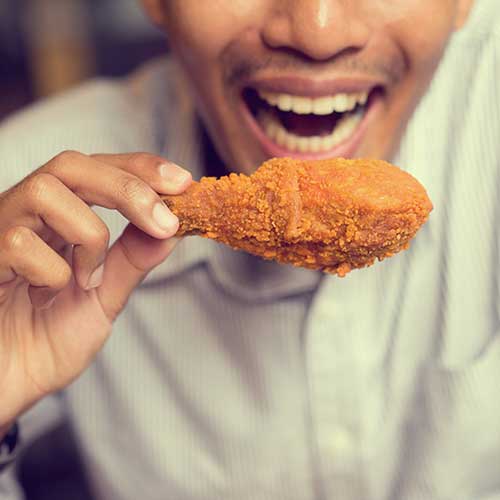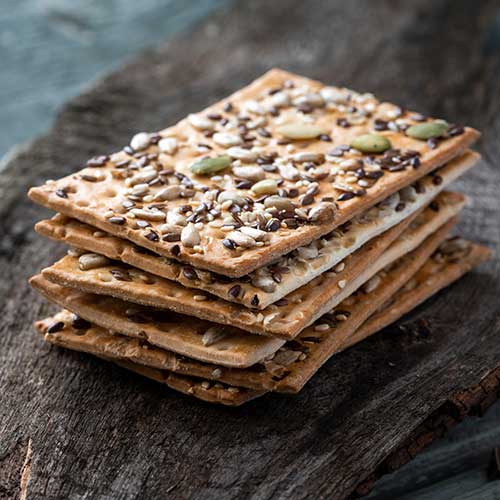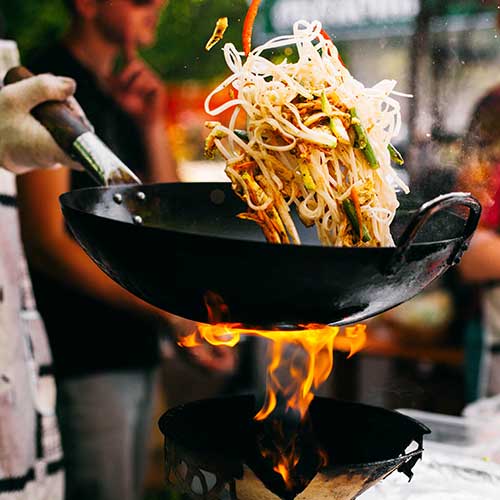Food Vocabulary
73 Words & Adjectives to Describe Food
Last updated on 2/11/2020When it comes to writing a menu, word choice is critical. Although menu pricing is important, the words you use to describe your food and how you make your menu could entice customers and increase sales if properly chosen. Conversely, a poorly written menu can turn customers off or confuse them if you’re not careful. Below, we break down the key components to menu writing and offer a list of descriptive words for food to get you started.
Words to Describe Taste

The flavor of your food is what most customers focus on when they are deciding what to eat. The way you engineer your menu can help build anticipation, and a good menu description could even convince a hesitant customer to try something new. With this in mind, it's important to be precise and thorough when choosing words to describe your food's flavor.
Here are some words that are commonly used to describe food:
- Acidic: A food with a sharp taste. Often used to refer to tart or sour foods as well.
- Bitter: A tart, sharp, and sometimes harsh flavor.
- Bittersweet: A less harsh taste than bitterness. Couples tartness with sweetness.
- Briny: Another word for salty.
- Citrusy: A bright flavor like that of lemons, limes, oranges, and other citrus fruits.
- Cooling: A taste that mimics the feeling of cold temperature. Often used to describe mint.
- Earthy: Reminiscent of fresh soil. Often used to describe red wines, root vegetables, and mushrooms.
- Fiery: A taste that feels as though it gives off heat. Another word for spicy.
- Fresh: A light and crisp taste. Often used to describe produce or herbs.
- Fruity: Any taste reminiscent of sweet fruit flavors.
- Full-bodied: Rich flavor that can feel heavy in the mouth. Often used to describe wines.
- Herbal: A bright, fresh, or sometimes earthy taste created by the incorporation of herbs.
- Honeyed: A sweet or candied taste that may be reminiscent of honey.
- Nutty: Any taste similar to the flavors of nuts. Often used to describe cheeses.
- Rich: A full, heavy flavor. Often used to describe foods containing cream.
- Robust: A rich taste with some earthiness. Often used to describe wines or aged liquors.
- Sharp: A harsh, bitter, or tart taste. Often used to describe acidic foods.
- Smoky: A smoky taste is reminiscent of the smell of smoke.
- Sour: A biting, tangy, tart flavor.
- Spicy: A burning taste from hot spices.
- Sweet: A sugary flavor.
- Tangy: A tart, biting taste that feels tingly in the mouth.
- Tart: A sharp, bitter, or sour flavor. Often used to describe acidic foods.
- Yeasty: An earthy taste reminiscent of yeast. Often used to describe beer and breads.
- Woody: An earthy, sometimes nutty taste. Often used to describe coffees or cheeses.
- Zesty: A fresh, vivid, or invigorating flavor.
Words to Describe Texture

Another consideration when describing your food is texture. Properly using food adjectives to describe mouthfeel helps your guests to imagine what it will be like to eat your food before they order it.
Here are some words that are commonly used to describe texture:
- Airy: A light, pillowy texture often created by the incorporation of air.
- Buttery: A smooth and creamy texture similar to that of butter.
- Chewy: The texture of a food that needs to be chewed thoroughly before swallowing. Can be light and bouncy or heavy and sticky.
- Creamy: A smooth and rich texture that usually comes from the incorporation of dairy.
- Crispy: A light texture with a slight crunch.
- Crumbly: The texture of a food with a loose structure that falls apart into small pieces or crumbs.
- Crunchy: A firm, crisp texture often identified by the sharp, audible noise that the food makes when being eaten.
- Crusty: The texture of a food with a hard outer layer and soft interior.
- Delicate: A light, fine texture that may come apart easily.
- Doughy: A soft and heavy texture that is often coupled with pale coloring.
- Fizzy: A texture brought on by the presence of many small bubbles, usually referring to carbonated liquids.
- Flaky: A light texture characterized by layers that come apart during eating.
- Fluffy: A light and airy texture.
- Gooey: A viscous, sometimes sticky texture arising from the presence of moisture in a dense solid food.
- Hearty: A firm, robust texture.
- Juicy: A succulent, tender texture characterized by the presence of liquid in a solid food.
- Silky: A fine, smooth texture characterized by a sleek feel in the mouth.
- Sticky: A texture characterized by gluiness in the mouth.
- Smooth: A consistent texture free of grit, lumps, or indentations.
- Succulent: A tender, juicy texture.
- Tender: A soft texture that is easy to break down.
- Velvety: A smooth and rich texture.
- Baked: A food that was cooked in an oven, often resulting in a crispy outer coating.
- Blanched: A food that was scalded in boiling water and then moved to cold water to stop cooking. Results in a softened texture.
- Blackened: A food that was dipped in butter and coated with spices before being cooked in a hot pan, resulting in a blackened appearance.
- Braised: Food that is briefly fried in a small amount of fat and then is slowly stewed in a covered pot. Results in a seared, crispy exterior coupled with a tender interior texture.
- Breaded: A breaded food is one that was coated with a breadcrumb mixture or batter that is then baked or fried into a crispy outer layer.
- Broiled: A food cooked with intense radiant heat, as in an oven or on a grill. Often results in a darkened appearance and crispy texture.
- Caramelized: A caramelized food is one that has been cooked slowly until it is browned and becomes sweeter in taste.
- Charred: Food that is grilled, roasted, or broiled and gains a blackened exterior coupled with a smoky flavor.
- Fermented: A food that has been introduced to bacteria, yeast, or another microorganism to produce organic acids, alcohols, or gases. May result in a pungent, biting flavor.
- Fried: Food that is cooked by submerging partially or fully into hot oil. Often results in a crispy or crunchy texture and golden color.
- Glazed: A food that becomes moistened by having a flavorful coating dripped or brushed onto its surface. May result in a glossy appearance and thin, crisp outer layer.
- Infused: A food that has been steeped in liquid with another ingredient in order to extract the flavor of the ingredient. Often used with herbs.
- Marinated: A food (usually meat) that has been soaked in liquid containing flavorful ingredients like herbs, spices, vinegar, and oil.
- Poached: Food that has been cooked in nearly boiling liquid. Often results in a tender, moist texture.
- Roasted: Food that has been cooked with dry heat in an oven or over a fire. Often results in a browned exterior and crisp coating.
- Sauteed: A food that has been cooked quickly in a small amount of fat.
- Seared: A food that is cooked in a small amount of fat until caramelized and then finished by roasting, grilling, or another method. Results in a crisp outer texture and tender interior.
- Smoked: Smoked food is food that is cooked or preserved by long exposure to smoke from smoldering wood. Results in a distinctive, bold flavor.
- Whipped: Food that has been beaten to incorporate air. Often results in a light, fluffy texture.
- Dry vs. crispy: Chicken with a dry breading compared to Chicken with a crispy breading
- Greasy vs. velvety: Pasta in a greasy sauce compared to Pasta in a velvety sauce
- Sugary vs. honeyed: Pears with a sugary drizzle compared to Pears with a honeyed drizzle
- Burned vs. blackened: Burned salmon compared to Blackened salmon
- Tough vs. hearty: A piece of tough bread compared to A piece of hearty bread
- Mushy vs. tender: A mushy crabcake compared to A tender crabcake
Words to Describe Food Preparation Method

One of the best ways to describe food on your menu is by indicating how it was prepared. So long as your customer recognizes the words you choose, it will give them a clear picture of your food's flavor and appearance.
Here are some words that indicate preparation and cooking method:
Positive Food Adjectives
The easiest way to accidentally influence your customers into passing over a menu item is to use a word with a negative connotation. Before you put a word in your menu description, take a moment to think about how that word is commonly used. Does it bring a positive image to mind, or is it unappetizing? Additionally, the positive alternatives to negative words are often more specific, so they give your customers a more precise idea of what your food is like.
Here are some examples of negative describing words and the positive food adjectives that you can use to replace them:
When you're trying to find the right words to describe the food on your menu, be sure to explore the hundreds of options that you have. Remember to use words that are appealing enough to catch a customer's eye, common enough to explain your food at a glance, and specialized enough that you don't have to resort to cliches. Next time you add a new dish or want to overhaul your menu, keep in mind that the time you invest in your menu descriptions can help sell your food to customers.
How’s It Taste?
Beyond “Delicious”
Ever notice how the word delicious is frequently used to describe food? Using this word too often can become boring. So let’s find some other ways to say delicious, shall we?
1. Tastes great!
Eating something delicious right now? Use this expression to say so.
I’m so glad I ordered this pizza—it tastes great!
2. Really good!
Here’s something else you could say instead of delicious.
Have you tried the chocolate cake? It’s really good!
3. Wow, [this food] is amazing!
If something tastes better than you expected, you could use the word wow to express your surprise. If you say something tastes amazing, you’re saying it tastes even better than great or really good.
Wow, this pasta salad is amazing!
4. Yummy
This is an informal way of saying something tastes good. If you find something to be delicious, you could simply say “Yummy!” or you could expand it into a sentence.
This cheesecake is really yummy. I’m going for another slice.
5. Flavorful
This is a great adjective for describing food that’s full of flavor or that has a delicious quality in its taste and smell.
I love how flavorful this soup is with all the fresh herbs and vegetables in it.
6. Mouth-watering
This is the perfect adjective to describe something that’s so delicious and flavorful, it’s actually making your mouth water.
His mom makes such mouth-watering cakes that I just can’t wait to go over to his house tonight.
Avoiding “Yuck”
There may be times when you don’t really like the taste of a certain food. But you probably can’t just shout “Yuck!” (an informal English word meaning something tastes or smells bad) without offending the cook or your hosts.
So how can you express that without sounding impolite?
7. This [food] is too [flavor] for me/for my taste.
This is a polite way to explain that you don’t like the food, without blaming the cook. It’s just not right for you.
Better yet if you can throw in a compliment first!
This cake is so moist! It’s just too sweet for my taste.
8. It could use a little more/less…
Use this expression to say that you’d like the food better if the flavors were different.
This chicken is too spicy. It could use a little less chili sauce.
9. This tastes different. I think I prefer [something else].
If something tastes new or unfamiliar, you could politely name some other food that you’d prefer or like better.
This tiramisu tastes different. I think I prefer the chocolate cake.
What’s Your Diet?
10. Vegetarian
If you’re a vegetarian, your diet would include only vegetables, fruits and non-meat items such as tofu, nuts, etc.
I’ve been a vegetarian for a year and I don’t even miss eating meat at all.
11. Trying to lose weight
If you’re trying to lose weight, it means you’re trying to become thinner.
I usually just have a salad for lunch because I’m trying to lose weight.
12. Low-carb diet
The word carb is short for carbohydrate. A low-carb diet involves eating less carbohydrate-rich foods such as bread, pancakes and cookies.
That strawberry muffin looks tempting, but I’m on a low-carb diet.
13. A balanced diet
Most people simply try to keep a balanced diet, which includes eating from each of the main food groups like grains, vegetables, fruits, dairy and meat.
To stay healthy, I go to the gym, cycle to work and eat a balanced diet.
What Do You Usually Eat?
This is one of the most common questions that people ask one another and it’s always interesting to hear everyone’s answers.
14. Fast food
Fast food is served very quickly over the counter at restaurants such as McDonald’s or Chick-fil-A. It’s usually a meal with hamburgers or sandwiches, French fries and soda.
When I’m busy with school, I usually end up eating fast food.
15. Home-cooked meal
A home-cooked meal is what many of us would like to have waiting for us when we get home from school or work. This is a fresh meal that’s made and eaten at home.
Whenever I get home early from work, I make myself a nice home-cooked meal.
16. One-pot meal
A one-pot meal means exactly what it says. You cook all of your ingredients (food items) like meat and vegetables in one pot and you’re ready to eat.
If I’m too tired to cook, I just make a quick and easy one-pot meal.
17. Dessert
Dessert is a sweet dish, like pastry or ice cream, that’s served and eaten at the end of a meal.
My grandma makes amazing cookies, cakes and pies. I always look forward to dessert when I go to her house.
18. To have a sweet tooth
Do you enjoy eating sweet food very much? Well then, you must have a sweet tooth for sure.
I’ll admit I have a sweet tooth because I can never say no to cakes, pastries and ice cream.
19. To eat healthy
Here’s an easy one. To eat healthy simply means choosing to eat food that’s good for your health.
No matter how busy I am, I try to eat healthy and exercise every day.
How Do You Like Your Chicken?
20. Fried or deep-fried
Fried chicken is made by cooking the meat in hot oil. Often the fried chicken we get at restaurants is actually deep-fried.
So what’s the difference between frying and deep-frying? Well, deep-frying uses a lot more oil than frying. Most times, people just say fried chicken when referring to deep-fried chicken because the word is shorter and easier to say.
I can’t think of anything I like better than fried chicken, can you?
21. Grilled
Grilled chicken is made by cooking the meat directly on a heated grill.
I think I’ll invite my friends over for some grilled chicken this weekend.
22. Crunchy
If you deep-fry your chicken well, it’ll be crunchy, which means it’ll make a crunching, cracking sound when you bite and chew on it.
That fried chicken I had for lunch was so crunchy and yummy I just can’t stop thinking about it.
How Do You Like Your Eggs?
23. Scrambled
Scrambled eggs are made by stirring and mixing them together while cooking.
I usually make scrambled eggs for breakfast because they’re so easy.
24. Poached
Poached eggs are made by partially cooking the egg in simmering water. When it’s served, the egg whites will be soft and you’ll be able to see the whole yolk.
I’ve never had a poached egg but I’d sure like to try it.
25. Sunny-side up
Sunny-side up refers to an egg that’s been fried on only one side. Its name comes from the fact that the yolk sits whole in the middle of the fried egg, making it look like the sun.
The only way my son will eat eggs is if I make them sunny-side up. He likes to see the yellow yolk!
On that sunny note, I hope you’ve learned some useful vocabulary here today that’ll boost your confidence before jumping into any discussion about food. Remember, the more you practice, the more natural you’ll sound. Happy learning and good luck!
Comments
Post a Comment